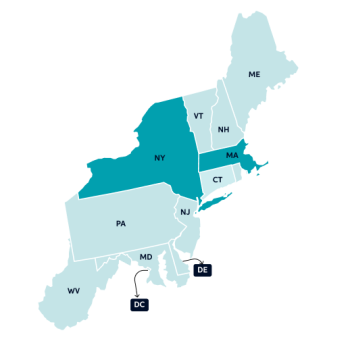

By Hunza Irfan | Tue, August 27, 24
Nationwide, electricity prices have risen in recent years. From 2022 to 2023, residential electricity prices rose 6.2 percent. When energy costs increase, more households face high or severe energy burden leading to economic energy insecurity – the inability to adequately meet basic household energy costs – and face difficult choices like trading off costs for heating or eating. Energy burden – the percentage of gross household income spent on energy costs – is considered high when it reaches six percent or more, and severe at 10 percent or above.
Nationally, 67 percent of low-income households experience a high energy burden, and out of these, 60 percent face a severe energy burden. This inequity is especially pronounced in the Northeast, with New England demonstrating the largest gap between low-income and median energy burdens, coupled with some of the highest energy costs in the country.
Moreover, as states invest more in decarbonization, these burdens may be exacerbated. For example, households in cold climates switching from natural gas to electricity can increase costs under existing rate structures and if weatherization measures are not adopted. It will be important to find ways to alleviate energy burdens through energy efficiency measures and utility rate structures designed to lower energy bills and help address this issue. This blog summarizes tools states can use to address energy burden through affordability programs and rate design, and highlights efforts currently underway in two states in our region, Massachusetts and New York.
Tools to Address Energy Affordability
Several policy and program options exist for states and utilities to address energy affordability. These include discount rates, payment plans, and disconnection protections. These options can be used together to form a comprehensive strategy to address affordability.
Discount rates are percentage discounts offered on utility bills to income-qualifying customers. Tiered discount rates (like those proposed by National Grid) offer varying discounts for different income levels and can include moderate-income households.
Discounted rates for electrification are designed to address the high energy burden that households opting for building decarbonization may experience. These rates are designed to discount at specific times or with the use of specific equipment (electric vehicles or heat pumps). These changes enable households to electrify without increased utility costs. For example, Central Maine Power is piloting two such programs on seasonal and electrification-focused rates, while Versant Power runs its own time-of-use programs for heat pumps.
Arrears Management Programs (AMPs) can help utility customers who have overdue bills (also known as arrears). Customers can experience spiraling energy costs when in arrears because they are required to pay both current charges and arrearages at the same time. With AMPs (such as those in Massachusetts and California), every on-time payment reduces a portion of the arrearage until it is completely covered. Another payment plan option is a Percentage of Income Payment Plans (PIPP). PIPPs (such as New Jersey’s Universal Service Fund Program) cap the amount of the utility bill payment depending on the participant household’s income. These are especially useful for low-income households and can be used along with other rate design options.
Disconnection Protections are policies that prohibit utility companies from shutting off service and can be based on specific protection types such as extremely cold or hot outdoor temperatures or a customer’s age. While these protections ensure continued access to energy, they do not help with rates and overdue bills. They should be accompanied by other discount policies.
Massachusetts Opens an Investigation on Energy Affordability
In Massachusetts, low-income households experience an average energy burden of 10 percent, with some neighborhoods experiencing 30 percent or more. Currently, Massachusetts offers discount rates, disconnection protection, and arrearage management programs. In 2022, the Department of Public Utilities (DPU) recognized the need for a better understanding of energy costs on households in the state and directed utilities to submit detailed utility burden index analysis with their annual reports.
This year, the state took additional steps to better understand and address energy costs and affordability. The Massachusetts Executive Office of Energy and Environmental Affairs (EEA), Massachusetts Department of Energy Resources (DOER), and the Office of the Attorney General (AGO) are collaborating on an Interagency Rates Working Group (IRWG) to produce near and long-term rate design strategies that align with the state’s decarbonization goals. The working group recently released a Near-Term Rates Strategy Draft Report and is hosting meetings to design the state’s strategies for the rest of the year. More information can be found here.
In January 2024, the DPU opened an inquiry on energy affordability for residential rate payers to examine energy burden and improve access and enrollment for affordability programs. Public comments were solicited on design of energy affordability programs, and the state conducted an Energy Burden Workshop in June 2024. Some important public concerns that emerged through this process include:
- Measuring Energy Burden: Energy burden should not only look at the percentage cost of energy over household income but also consider whether households are well-protected against extreme weather events, reliability, and consumption patterns. Factoring in these elements provides a better picture of energy burden and usage.
- Income Verification Processes: Income-based assistance programs have a high administrative burden due to complex verification processes that can take time and be specific for each program. Leveraging automatic enrolment can help alleviate this problem and make programs more accessible.
- Protection Against Shut-offs/Disconnection: Shut-offs can create more expenses for utility customers and, especially in extreme weather conditions, can present health and safety issues. Considerations for how to handle shut-offs and any associated costs should also be a part of these discussions.
- Addressing Cliffs: Customers who transition from low-income to moderate-income lose their eligibility to participate in income-based assistance programs and experience a shocking “cliff” of high bills that can significantly increase their burden. Rate plans should accommodate for a steady change for these transitioning customers.
- Coordination with Utilities: To compensate for low-income discounted rates, utilities might increase fixed charges such as delivery and transmission costs for ratepayers. This appeared to be one of the most pressing issues. It is important to coordinate with utilities to ensure rates are equitably distributed among all customers and ensure transparency in how rates are designed.
Interested stakeholders can track the proceeding here.
New York Announces an Affordability Guarantee Pilot
In New York, low-income households experience an average energy burden of 13 percent. Since 2016, New York has had a policy to address energy affordability and most recently approved a statewide energy affordability program.
In 2016, the Public Service Commission of New York (PSC) adopted an Energy Affordability Policy. This set the target energy burden at six percent or lower for all 2.3 million low-income households in the state, and required all major utility companies to administer the Energy Affordability Program (EAP), which automatically enrolls limited income consumers and provides them with a discount rate. A funding limit was established so that the total budget for each utility would not exceed two percent of their revenues. In 2023, just over one million low-income households were enrolled in the EAP, with total expenditures of over $450 million across New York State.
Most recently, the state has been piloting ways to embed the Energy Affordability policy in decarbonization efforts. In 2023, New York’s Governor Hochul announced the creation of a first-of-its-kind Energy Affordability Guarantee Pilot to support the state’s EmPower+ program, which helps low- and moderate-income households save energy and money through energy efficiency measures and efficient electric equipment. The Energy Affordability Guarantee Pilot offers a “guarantee” of maximum six percent energy burden threshold to households who fully electrify their homes through EmPower+. In 2024, the PSC considered the Department of Public Service proposal for the Energy Affordability Guarantee Pilot and solicited public comments. Key concerns that emerged from staff and other stakeholders in this proceeding include: in this proceeding include:
- Ground Eligibility Criterion in Geographic Realities: Urban cores like NYC, as well as some other parts of the state, experience significantly higher costs of living compared to the rest of their respective states resulting in a higher number of people facing energy burden. Eligibility criteria should consider area median income (AMI) and geographic distribution should favor households in these areas.
- Prevent Delays in Credits: Low-income customers need immediate relief, and extensive delays in processing credits or inaccurate bills can undermine the purpose of the Pilot.
On August 15, the PSC approved implementation of the Pilot. The PSC expects this Pilot will enable the state to craft strategies to promote decarbonization, energy affordability, and consumer protections for its most vulnerable households. This Guarantee Pilot is an example of how electrification measures can be supported through affordability programs, making electrification more attractive and ensuring that the energy transition is more equitable for low-income households.
Conclusion
Energy affordability programs and strategies are crucial for addressing the affordability crisis that inflicts households in the Northeast, especially as states pursue decarbonization goals in the face of increasing impacts from climate change. High energy burden and energy insecurity can harm one’s well-being and health, and special attention should be paid to our most vulnerable populations when designing energy programs and policies. NEEP is encouraged to see two states in our region taking steps to address this important issue by increasing overall affordability and combining affordability programs with energy efficiency and decarbonization efforts.

